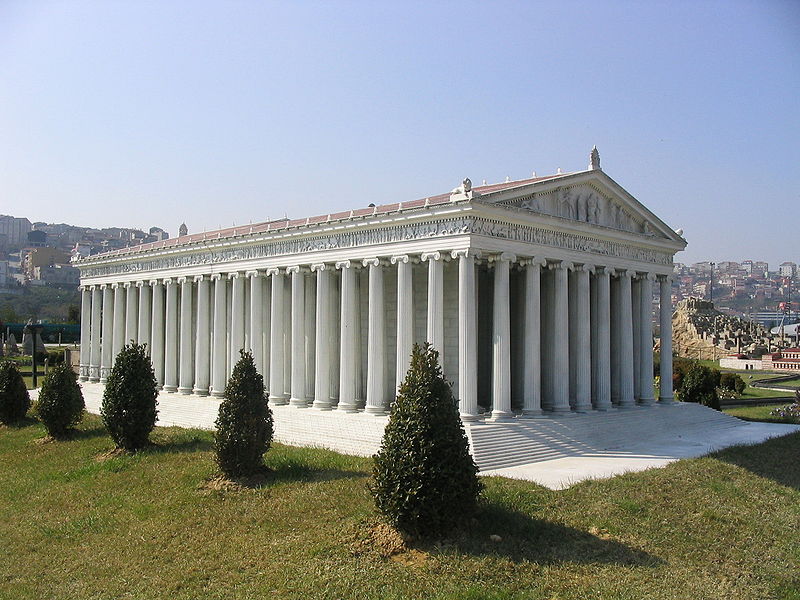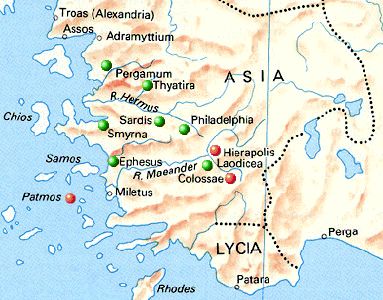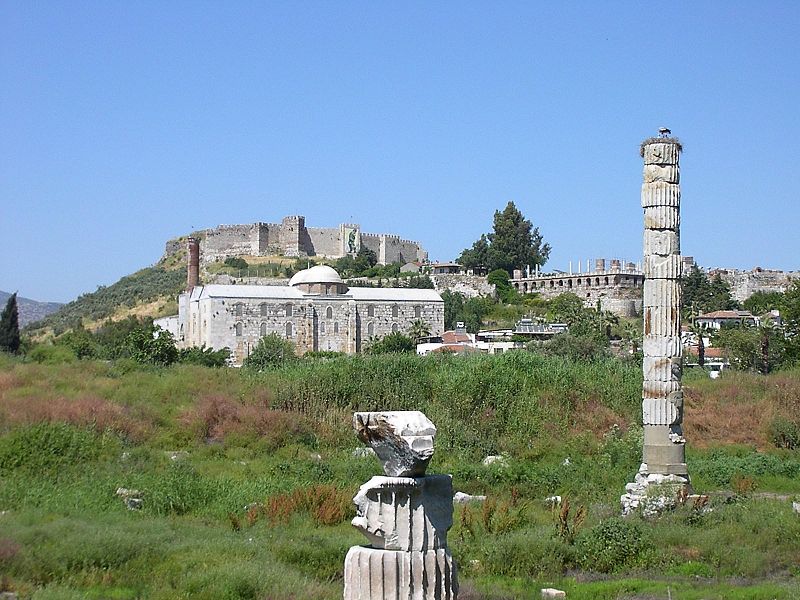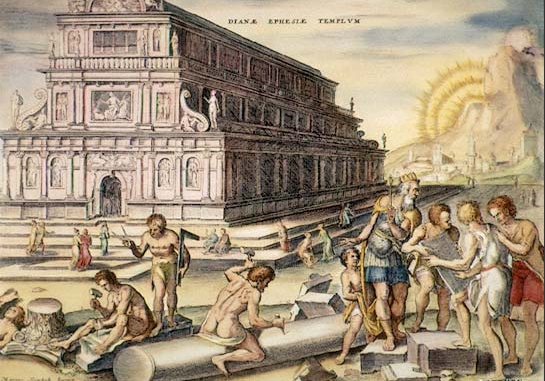<Back to Index>
- Ephesus, Turkey The Temple of Artemis (Αρτεμίσιον), 550 B.C.
PAGE SPONSOR


The Temple of Artemis (Greek: Ἀρτεμίσιον, or Artemision), also known less precisely as the Temple of Diana, was a Greek temple dedicated to a goddess Greeks identified as Artemis and was one of the Seven Wonders of the Ancient World. It was situated at Ephesus (near the modern town of Selçuk in present day Turkey), and was completely rebuilt three times before its eventual destruction in 401. Only foundations and sculptural fragments of the latest of the temples at the site remain.
The first sanctuary (temenos) antedated the Ionic immigration by many years, and dates to the Bronze Age. Callimachus, in his Hymn to Artemis, attributed it to the Amazons. In the 7th century the old temple was destroyed by a flood. Its reconstruction began around 550 BC, under the Cretan architect Chersiphron and his son Metagenes, at the expense of Croesus of Lydia: the project took 10 years to complete, only to be destroyed in an act of arson by a young arsonist seeking fame named Herostratus. It was later rebuilt.
Antipater of Sidon, who compiled the list of the Seven Wonders, describes the finished temple:
I have set eyes on the wall of lofty Babylon on which is a road for chariots, and the statue of Zeus by the Alpheus, and the hanging gardens, and the colossus of the Sun, and the huge labor of the high pyramids, and the vast tomb of Mausolus; but when I saw the house of Artemis that mounted to the clouds, those other marvels lost their brilliancy, and I said, "Lo, apart from Olympus, the Sun never looked on aught so grand".
The Temple of Artemis was located near the ancient city of Ephesus, about 50 km south from the modern port city of İzmir, in Turkey. Today the site lies on the edge of the modern town of Selçuk.
The sacred site (temenos) at Ephesus was far older than the Artemision itself. Pausanias was certain that it antedated the Ionic immigration by many years, being older even than the oracular shrine of Apollo at Didyma. He said that the pre - Ionic inhabitants of the city were Leleges and Lydians. Callimachus, in his Hymn to Artemis, attributed the earliest temenos at Ephesus to the Amazons, whose worship he imagines already centered upon an image (bretas) of Artemis, their patron goddess.
Modern archaeology cannot confirm Pausanias' Amazons, but his account of the site's antiquity seems well founded. Before World War I, site excavations by David George Hogarth identified three successive temple buildings. Re-excavations in 1987 - 88 confirmed that the site was occupied as early as the Bronze Age, with a sequence of pottery finds that extend forward to Middle Geometric times, when the clay floored peripteral temple was constructed, in the second half of the 8th century BC. The peripteral temple at Ephesus offers the earliest example of a peripteral type on the coast of Asia Minor, and perhaps the earliest Greek temple surrounded by colonnades anywhere.
In the 7th century, a flood destroyed
the temple, depositing over half a meter of sand and flotsam over a
floor of hard packed clay. Among the flood debris were the remains of a
carved ivory plaque of a griffin and the Tree of Life,
apparently North Syrian, and a number of drilled tear shaped amber
drops of elliptical cross section. These probably once dressed a wooden
effigy (xoanon) of
the Lady of Ephesus, which must have been destroyed or recovered from
the flood. Bammer notes that though the site was prone to flooding, and
raised by silt deposits about two meters between the eighth and 6th
centuries, and a further 2.4 m between the sixth and the fourth, its
continued use "indicates that maintaining the identity of the actual
location played an important role in the sacred organization".
The new temple was sponsored at least in part by Croesus, who founded Lydia's empire and was overlord of Ephesus, and was designed and constructed from around 550 BC by the Cretan architect Chersiphron and his son Metagenes. It was some 377' long and 180' wide, supposedly the first Greek temple built of marble. Its peripteral columns stood some 40 feet high, in double rows that formed a wide ceremonial passage around the cella that housed the goddess' cult image. Thirty - six of these columns were, according to Pliny, decorated by carvings in relief. A new ebony or blackened grape wood cult statue was sculpted by Endoios, and a naiskos to house it was erected east of the open - air altar.
A
rich foundation deposit from this era yielded more than a thousand
items, including what may be the earliest coins made from the
silver - gold alloy electrum.
Fragments of bas relief on the lowest drums of the temple, preserved in
the British Museum, show that the enriched columns of the later temple,
of which a few survive were versions of this earlier feature. Pliny the Elder,
seemingly unaware of the ancient continuity of the sacred site, claims
that the new temple's architects chose to build it on marshy ground as a
precaution against earthquakes. The temple became an important
attraction, visited by merchants, kings, and sightseers, many of whom
paid homage to Artemis in the form of jewelry and
various goods. It also offered sanctuary to those fleeing persecution
or punishment, a tradition linked in myth to the Amazons who twice fled
there seeking the goddess' protection from punishment, firstly by Dionysus and later, by Heracles.
The "Croesus" Temple was destroyed on July 21, 356 BC, probably very soon after its completion, in a vainglorious act of arson: one Herostratus set fire to the roof beams, seeking fame at any cost, thus the term herostratic fame.
A man was found to plan the burning of the temple of Ephesian Diana so that through the destruction of this most beautiful building his name might be spread through the whole world.
The Ephesians, outraged, sentenced Herostratus to death and forbade anyone from mentioning his name, under pain of death. However, Theopompus later noted the name. The burning supposedly coincided with the birth of Alexander the Great; Plutarch remarked that Artemis was too preoccupied with Alexander's delivery to save her burning temple.
The
Ephesians tactfully refused Alexander's offer to pay for the temple's
rebuilding, and eventually rebuilt it after his death, at their own
expense. Work started in 323 BC and continued for many years. The third
temple was larger than the second; 450' long by 225' wide and 60 feet high, with more than 127 columns. Athenagoras of Athens names Endoeus, a pupil of Daedalus, as sculptor of Artemis' main cult image. Pausanias (c. 2nd century AD) reports another image and altar in the Temple, dedicated to Artemis Protothronia (Artemis "of the first seat") and a gallery of images above this altar, including an ancient figure of Nyx (the primordial goddess of Night) by the sculptor Rhoecus (6th
century BC). Pliny describes images of Amazons, the legendary founders
of Ephesus and Ephesian Artemis' original proteges, carved by Scopas. Literary sources describe the temple's adornment by paintings, gilded
columns of gold and silver, and religious works of renowned Greek sculptors Polyclitus, Pheidias, Cresilas, and Phradmon.
This reconstruction survived some 600 years, and appears multiple times in early Christian accounts of Ephesus. According to the New Testament, the appearance of the first Christian missionary in Ephesus caused locals to fear for the temple's dishonor. The 2nd century Acts of John includes an apocryphal tale of the temple's destruction: the apostle John prayed publicly in the Temple of Artemis, exorcising its demons and "of a sudden the altar of Artemis split in many pieces... and half the temple fell down," instantly converting the Ephesians, who wept, prayed or took flight. Against this, a Roman edict of 162 AD acknowledges the importance of Artemesion, the annual Ephesian festival to Artemis, and officially extends it from a few holy days over March – April to a whole month, "one of the largest and most magnificent religious festivals in Ephesus' liturgical calendar".
In 268 AD, the Temple was destroyed or damaged in a raid by the Goths, an East Germanic tribe. in the time of emperor Gallienus: "Respa, Veduc and Thuruar, leaders of the Goths, took ship and sailed across the strait of the Hellespont to Asia. There they laid waste many populous cities and set fire to the renowned temple of Diana at Ephesus," reported Jordanes in Getica.
Thereafter it may have been rebuilt, or repaired but this is uncertain, as its later history is highly unclear and the torching of the temple by the Goths may have brought it to a final end. At least some of the stones from the temple were used in construction of other buildings. Some of the columns in Hagia Sophia originally belonged to the temple of Artemis, and the Parastaseis syntomoi chronikai records the re-use of several statues and other decorative elements throughout Constantinople.
The main primary sources for the Temple of Artemis at Ephesus are Pliny the Elder's Natural History XXXVI.xxi.95, Pomponius Melai:17, and Plutarch's Life of Alexander III.5 (referencing the burning of the Artemiseum).
After sixty years of searching, the site of the temple was rediscovered in 1869 by an expedition led by John Turtle Wood and sponsored by the British Museum. These excavations continued until 1874. A few further fragments of sculpture were found during the 1904 - 06 excavations directed by David George Hogarth. The recovered sculptured fragments of the 4th century rebuilding and a few from the earlier temple, which had been used in the rubble fill for the rebuilding, were assembled and displayed in the "Ephesus Room" of the British Museum.
Today the site of the temple, which lies just outside Selçuk, is marked by a single column constructed of dissociated fragments discovered on the site.
The archaic temeton beneath the later Temples clearly housed some form of "Great Goddess" but nothing is known of her cult. The literary accounts that describe it as "Amazonian" refer to the later founder - myths of Greek emigres who developed the cult and temple of Artemis Ephesia. The wealth and splendor of temple and city were taken as evidence of Artemis Ephesia's power, and were the basis for her local and international prestige: despite the successive traumas of Temple destruction, each rebuilding – a gift and honor to the goddess – brought further prosperity.
Artemis' shrines, temples and festivals (Artemisia) could be found throughout the Greek world, but Ephesian Artemis was unique. The Ephesians considered her theirs, and resented any foreign claims to her protection. Once Persia ousted and replaced their Lydian overlord Croesus, the Ephesians played down his contribution to the Temple's restoration. On the whole, the Persians dealt fairly with Ephesus, but removed some religious artifacts from Artemis' Temple to Sardis and brought Persian priests into her Ephesian cult; this was not forgiven. When Alexander conquered the Persians, his offer to finance the Temple's second rebuilding was politely but firmly refused. Ephesian Artemis lent her city's diplomacy a powerful religious edge.
Under Hellenic rule, and later, under Roman rule, the Ephesian Artemisia festival was increasingly promoted as a key element in the pan - Hellenic festival circuit. It was part of a definitively Greek political and cultural identity, essential to the economic life of the region, and an excellent opportunity for young, unmarried Greeks of both sexes to seek out marriage partners. Games, contests and theatrical performances were held in the goddess' name, and Pliny describes her procession as a magnificent crowd - puller; one of Apelles' best paintings showed the goddess' image, carried through the streets and surrounded by maidens. In the Roman Imperial era, the emperor Commodus lent his name to the festival games, and might have sponsored them.
From the Greek point of view Ephesian Artemis is a distinctive form of their goddess Artemis. In Greek cult and myth, Artemis is the twin of Apollo, a virgin huntress who supplanted the Titan Selene as goddess of the Moon. At Ephesus, a goddess whom the Greeks associated with Artemis was venerated in an archaic, certainly pre - Hellenic cult image that was carved of wood and kept decorated with jewelry. Robert Fleischer identified as decorations of the primitive xoanon the changeable features that since Minucius Felix and Jerome's
Christian attacks on pagan popular religion had been read as many
breasts or "eggs" — denoting her fertility (others interpret the objects
to represent the testicles of sacrificed bulls that would have been
strung on the image, with similar meaning). Most similar to Near - Eastern
and Egyptian deities, and least similar to Greek ones, her body and
legs are enclosed within a tapering pillar - like term, from which her feet protrude. On the coins minted at Ephesus, the apparently many - breasted goddess wears a mural crown (like a city's walls), an attribute of Cybele. On the coins she rests either arm on a staff formed of entwined serpents or of a stack of ouroboroi, the eternal serpent with its tail in its mouth. Something the Lady of Ephesus had in common with Cybele was that each was served by temple slave - women, or hierodules (hiero "holy", doule "female
slave"), under the direction of a priestess who inherited her role,
attended by a college of eunuch priests called "Megabyzoi" and also by young virgins (korai).
The "eggs" or "breasts" of the Lady of Ephesus, it now appears, must be the iconographic descendants of the amber gourd shaped drops, elliptical in cross section and drilled for hanging, that were rediscovered in the excavations of 1987 - 88; they remained in situ where the ancient wooden cult figure of the Lady of Ephesus had been caught by an 8th century flood. This form of breast - jewelry, then, had already been developed by the Geometric Period. A hypothesis offered by Gerard Seiterle, that the objects in Classical representations represented bulls' scrotal sacs cannot be maintained.
A votive inscription mentioned by Florence Mary Bennett, which dates probably from about the 3rd century BC, associates Ephesian Artemis with Crete: "To the Healer of diseases, to Apollo, Giver of Light to mortals, Eutyches has set up in votive offering [a statue of] the Cretan Lady of Ephesus, the Light - Bearer."
The Greek habits of syncretism assimilated all foreign gods under some form of the Olympian pantheon familiar to them — in interpretatio graeca — and it is clear that at Ephesus, the identification with Artemis that the Ionian settlers made of the "Lady of Ephesus" was slender. The Christian approach was at variance with the tolerant syncretistic approach of pagans to gods who were not theirs. A Christian inscription at Ephesus suggests why so little remains at the site:
"Destroying the delusive image of the demon Artemis, Demeas has erected this symbol of Truth, the God that drives away idols, and the Cross of priests, deathless and victorious sign of Christ."
The assertion that the Ephesians thought that their cult image had fallen from the sky, though it was a familiar origin - myth at other sites, is only known at Ephesus from Acts 19:35:
"What man is there that knoweth not how that the city of the Ephesians is a worshipper of the great goddess Diana, and of the [image] which fell down from Jupiter?"
Lynn
LiDonnici observes that modern scholars are likely to be more concerned
with origins of the Lady of Ephesus and her iconology than her
adherents were at any point in time, and are prone to creating a
synthetic account of the Lady of Ephesus by drawing together
documentation that ranges over more than a millennium in its origins,
creating a falsified, unitary picture, as of an unchanging icon.

